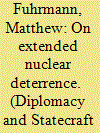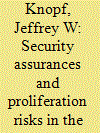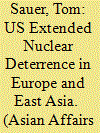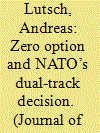| Srl | Item |
| 1 |
ID:
108416


|
|
|
|
|
| Publication |
2011.
|
| Summary/Abstract |
A number of commentators have claimed that the strategic relevance of extended nuclear deterrence is declining in the twenty-first century. This claim is based on three key arguments. First, that the positive effects of extended nuclear deterrence have been exaggerated by its proponents; second, that the rational actor logic underpinning extended nuclear deterrence is increasingly redundant; and third, that extended deterrence using conventional weapons is equally, if not more, effective as extended nuclear deterrence. This article applies these arguments to East Asia, a region where nuclear weapons continue to loom large in states' security equations. In applying each of the above arguments to the East Asian context, the analysis finds that not only is extended nuclear deterrence alive and kicking in the region, but also that in the coming decades it is likely to become more central to the strategic policies of the United States and its key allies, Japan and South Korea. Despite predictions of its demise, US extended nuclear deterrence remains a critical element in East Asia's security order and will remain so for the foreseeable future.
|
|
|
|
|
|
|
|
|
|
|
|
|
|
|
|
| 2 |
ID:
146628


|
|
|
|
|
| Summary/Abstract |
Recent nuclear-weapons-related consultation in NATO within the framework of the Defence and Deterrence Posture Review sheds light on historical experiences with nuclear consultation in NATO. In the early years of the Nuclear Planning Group (NPG), which became the main forum for multilateral nuclear consultation in the alliance, developing a nuclear weapons first use doctrine was of particular importance. This process led to the adoption of the Provisional Political Guidelines (PPGs) on the threat to initiate the use of nuclear weapons. With a focus on West Germany as the primary addressee of the NPG, it will be postulated that nuclear consultation functioned and may still be seen as an essential tool to manage the credibility of US extended nuclear deterrence in the framework of NATO.
|
|
|
|
|
|
|
|
|
|
|
|
|
|
|
|
| 3 |
ID:
158520


|
|
|
|
|
| Summary/Abstract |
This analysis discusses the central challenges that countries face when they practice extended nuclear deterrence. One key problem has to do with credibility: potential aggressors may not believe that a country would fight to defend an ally, particularly if doing so risks a nuclear attack against its homeland. Countries might be able to address this issue by forging formal alliances with protégés or by stationing nuclear forces on the protégé’s territory. Do these measures discourage third-party aggression? Defence pacts involving nuclear-armed states effectively bolster extended deterrence. One risk of extending nuclear protection from the American perspective, however, is that it might pull the United States into unwanted wars by risk-acceptant protégés. Yet, in a nuclear context, the risk of alliance entrapment is generally overblown. Placing nuclear weapons on an ally’s territory does much less to bolster extended deterrence than one might initially think. Although foreign nuclear deployments may reassure allies and promote non-proliferation to some degree, their value for extended deterrence is fairly minimal. The United States continues to deploy nuclear weapons in five European countries, but the case for maintaining these deployments is decidedly weak.
|
|
|
|
|
|
|
|
|
|
|
|
|
|
|
|
| 4 |
ID:
152376


|
|
|
|
|
| Summary/Abstract |
Comments that Donald Trump made while campaigning to be U.S. president have raised concerns that his administration will pull back from U.S. alliance commitments and encourage countries such as Japan and South Korea to acquire nuclear arms. The new article by Frühling and O’Neil outlines an institutional framework that can be helpful in assessing the risks that Trump administration policies will lead to nuclear proliferation. An institutional perspective shows that important elements of U.S. security assurances will continue to function, and this reduces the chances that President Trump’s actions or statements will trigger proliferation by U.S. allies. The greatest risk to global non-proliferation efforts posed by a Trump administration in fact lies elsewhere, in the possibility that President Trump will seek to abrogate the Iran nuclear deal.
|
|
|
|
|
|
|
|
|
|
|
|
|
|
|
|
| 5 |
ID:
187212


|
|
|
|
|
| Summary/Abstract |
Analysing the alliance system in Europe and Asia in a comparative perspective also demands having a look at the specific role of nuclear weapons in the defence doctrines, and more in particular the role of US extended nuclear deterrence. The main question that this article wants to resolve is: what are the similarities and differences in both regions with respect to extended nuclear deterrence? This (comparative) descriptive analysis is complimented with the following predictive question: which trends in both regions make it likely that extended nuclear deterrence will be strengthened, weakened, or maybe completely disappear? To answer these questions, the following structure is followed: first, the concept of extended nuclear deterrence will be described; next, this concept of extended nuclear deterrence will be applied to Europe and Asia; lastly, three trends that have an impact on the current debate on extended nuclear deterrence are analysed: 1) the deteriorating security situation; 2) the changing balance of power, and more in particular the relative decline of the US and the rise of China; and 3) the evolving nuclear arms control and disarmament regime, including the arrival of the Treaty on the Prohibition of Nuclear Weapons (TPNW).
|
|
|
|
|
|
|
|
|
|
|
|
|
|
|
|
| 6 |
ID:
175630


|
|
|
|
|
| Summary/Abstract |
An insufficiently understood paradox surrounded the NATO dual-track decision. This paradox was at the core of an almost classical high impact-low probability scenario which became reality with the INF Treaty of 1987, bringing NATO closer to a crisis of to be or not to be. NATO governments (except France) formally decided in 1979 that new long-range missiles in Europe were necessary but lacked political willpower to exclude the zero option, the possibility that NATO’s missile deployments may be obviated through arms control. The article analyses why this was the case, clarifies why this mattered, and draws policy implications from this crucial episode.
|
|
|
|
|
|
|
|
|
|
|
|
|
|
|
|